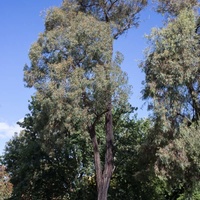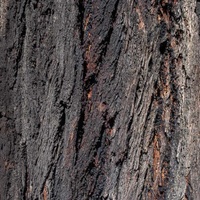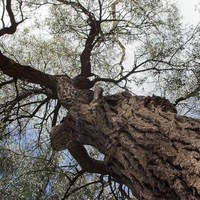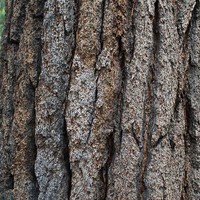Common name: Red ironbark
Other common names: Black ironbark, Mugga, Mugga ironbark, Red flowering ironbark, Three fruit red ironbark
Description
Red ironbark is a eucalyptus species from inland eastern Australia, where it occurs in woodland pockets distributed across warm temperate and subtropical regions. A valuable tree, it yields timber, essential oil and nectar for honey production.
It may reach a height of up to 30 m (98 ft) in its natural habitat, though it is more commonly 15 to 20 m (50 to 65 ft) tall and grows slowly to moderately fast.
The shape of the trunk varies with the growing conditions, from crooked to straight and is usually branch-free for up to half the tree's height. Branching starts close to the ground on young trees, with the lower branches self-pruning as the tree grows, forming a compact, irregular crown on older trees. The bark is dark red-brown to near black, thick, tough and deeply furrowed.
Leaves are lance-shaped, up to 12 cm (4.7 in ) long, grey-green and remain on the tree in all seasons. They have a camphor-like aroma when crushed.
The flowers are typical of Eucalyptus species, with long filaments, commonly white though occasionally red or pink, depending on the variety. They bloom in the subtropical parts of its range from winter to spring and in loose clusters of three to seven. Fertilised flowers develop into small goblet-shaped seed capsules that turn red-brown when mature, with many small, egg-shaped seed inside.
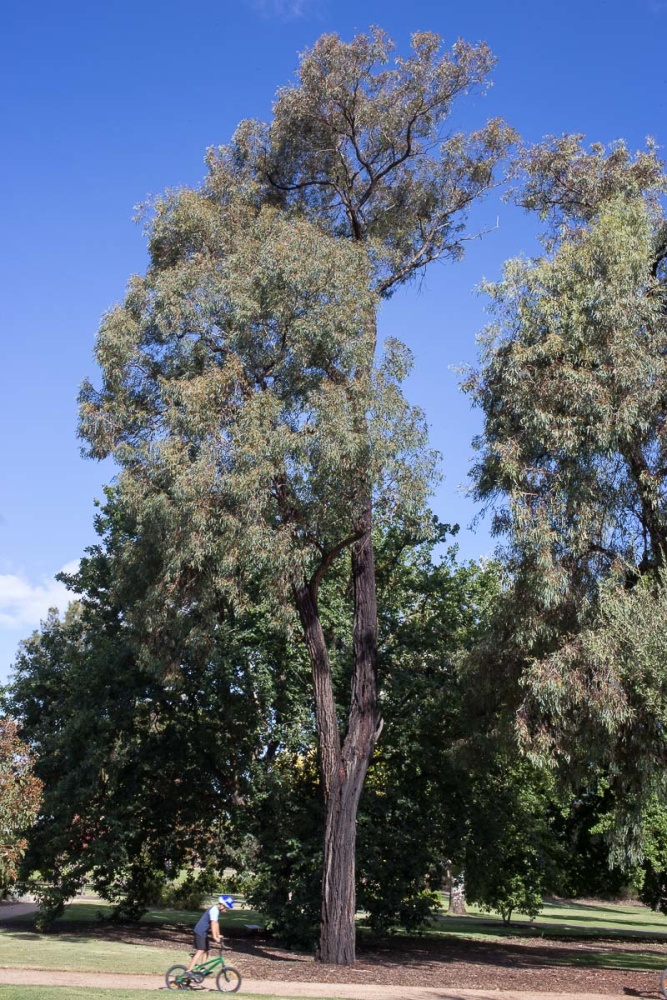
Bendigo Botanic Gardens, Victoria, Australia
Use
Red ironbark produces a heavy wood, averaging 950 kgs per cubic meter (59 lbs per cubic ft), with high natural resistance to rot, decay and termites. This makes it a durable hardwood suitable for indoor and outdoor construction.
Well-formed logs are sawn into planks for light construction, such as flooring, decking, outdoor furniture, picket fencing, or beams for heavy construction, including railway sleepers and parts used in constructing bridges and piers. The heartwood is an attractive reddish-brown.
Small diameter lengths are cut for poles and posts, firewood and for making charcoal. Since the tree coppices well (re-grows after being cut back to ground level), it has the potential to be grown more widely for fuelwood, particularly in dry climates.
The leaves yield a reddish-yellow Eucalyptus oil of the cineole type, extracted by steam distillation, though in small amounts of around 0.75% by weight. Because of their low oil yield, the leaves are usually only harvested when mixed with the leaves of high oil-yielding Eucalyptus species, such as those of the Blue mallee (Eucalyptus polybractea), a species with which it shares a common distribution.
The oil is used mostly for medicinal purposes, including as an ingredient in balms, ointments, liniments (salves), oral hygiene and aromatherapy products. Eucalyptus oils are more generally used in cleaning, disinfecting, perfumery, pharmaceutical, personal care and pest insect control products. Eucalyptus oil is also a good stain remover, having proven effective in removing grease, glue and dried stains from both skin and clothing.
The flowers produce significant quantities of nectar, and it is considered a major honey tree in Queensland and New South Wales, in its native Australia, and in the Transvaal in South Africa, where it is an introduced species. However, it does not produce enough pollen to sustain brood-rearing honeybees, so a separate pollen source is needed to maintain and build bee colonies for honey production. The pure honey is extra light to light amber with a mild flavour, good body and is quick to granulate, resulting in a fine grain or crystal.
The nectar-rich flowers also sustain wildlife in its natural range, most notably the endangered Regent Honeyeater, a small bird of the Australian outback with striking yellow and black plumage.
Pink- and red-flowering forms of the tree are cultivated as ornamentals in Australia and other countries, mainly as a street tree and for cut foliage used in floral arrangements.
Climate
Grows naturally in dry to sub-humid warm temperate and subtropical climates, generally areas with annual lows of 6 to 16°C, annual highs of 19 to 32°C, annual rainfall of 400 to 1300 mm and a dry season of 10 months or less. It achieves its best development, however, in areas with annual rainfall of 700 mm or more.
Growing
New plants are usually started from seed, germinating readily and remaining viable for several years under cold, dry, airtight conditions.
Performs best on free-draining clay-loam, loam, sandy-loam and loamy-sand soils of a slightly acid to moderately alkaline nature, generally with a pH of 6.5 to 8.0, and on sites with full sun exposure.
Problem features
The seed are small, though it is unknown how easily they can be dispersed. It is recorded as an invasive species in South Africa. Still, it is assessed to be a low weed risk for Hawaii by the Hawaii Pacific Weed Risk Assessment (HPWRA) project.
A minimum planting distance of 4 m (13 ft) from underground pipes is recommended.
Prolonged skin contact with Eucalyptus essential oil may cause burning dermatitis and blisters in some people. It can be poisonous if ingested in large amounts.
Where it grows
References
Books
-
Arctander, S. 1960, Perfume and flavor materials of natural origin, Elizabeth, New Jersey
-
Blake, S. T. & Roff, C. 1987, The honey flora of Queensland, 3rd ed., Queensland Department of Primary Industries (QLD DPI), Brisbane
-
Boland D.J., Brophy J.J. & House A. P. N. 1991, Eucalyptus leaf oils, use, chemistry, distillation and marketing, Australian Centre for International Agricultural Research (ACIAR) & Commonwealth Scientific Industrial Research(CSIRO), Inkata Press, Melbourne
-
Boland, D. & Brooker, I. & McDonald, M. W. 2006, Forest trees of Australia, 5th ed., CSIRO Publishing (Ensis), Melbourne
-
C.A.B. International 2013, The CABI encyclopedia of forest trees, CABI Publishing, Wallingford, Oxfordshire
-
Clarke, B. & McLeod, I. & Vercoe, T. 2009, Trees for farm Forestry : 22 Promising Species, Rural Industries Research and Development Corporation (RIRDC), Wagga Wagga, New South Wales
-
Crane, E., Walker, P. & Day, R. 1984, Directory of important world honey sources, International Bee Research Association, London
-
Cribb, A. B. & Cribb, J. W. 1982, Useful wild plants in Australia, William Collins, Sydney
-
Culbreth, D. M. R. 1927, A manual of materia medica and pharmacology : comprising the organic and inorganic drugs which are or have been recognized by the United States pharmacopeia, 7th ed., Febiger, Philadelphia
-
Editors of Sunset Magazine 2012, The New Western Garden Book: The Ultimate Gardening Guide, 9th edition, Sunset Publishing Corporation, California
-
F. R. Beuhne 1922, Honey flora of Victoria, Melbourne Albert J. Mullett, Govt. printer
-
Guenther, E. & Althausen, D. 1948 to 1952, The essential oils (6 volumes), Van Nostrand Publishing, New York
-
Hall, N. 1972, The use of trees and shrubs in the dry country of Australia, Australian Government Publishing Service, Canberra, Australian Capital Territory
-
Holliday, I. 2002, A field guide to Australian trees, 3rd revised editon, New Holland Publishers, Frenchs Forest, New South Wales
-
Leech, M. 2013, Bee Friendly: A planting guide for European honeybees and Australian native pollinators, Rural Industries Research and Development Corporation (RIRDC), Canberra, Australian Capital Territory
-
Little, E. L. & Skolmen, R. G. 1989, Common forest trees of Hawaii (native and introduced), Agricultuural Handbook No. 679, Forest Service, U.S. Department of Agriculture, Washington, D.C.
-
Perry, B. 2010, Landscape plants for California gardens: an illustrated reference of plants for California landscapes, Land Design Publishing, Claremont, California
-
Randall, R. P. 2002, A global compendium of weeds, R.G. and F.J. Richardson Press, Melbourne
-
Scheffer, T. C & Morrell, J. J. 1998, Natural durability of wood : a worldwide checklist of species, Forest Research Laboratory, Oregon State University, Corvallis, Oregon
-
Streets, R. J. & Troup, R. S. 1962, Exotic forest trees in the British Commonwealth, Oxford University Press, Oxford, England
-
Webb, D. B. 1984, A Guide to species selection for tropical and sub-tropical plantations, 2nd ed., Unit of Tropical Silviculture, Commonwealth Forestry Institute, University of Oxford, Oxfordshire
-
Weiss, E. A. 1997, Essential oil crops, CABI Publishing, Wallingford, Oxfordshire
